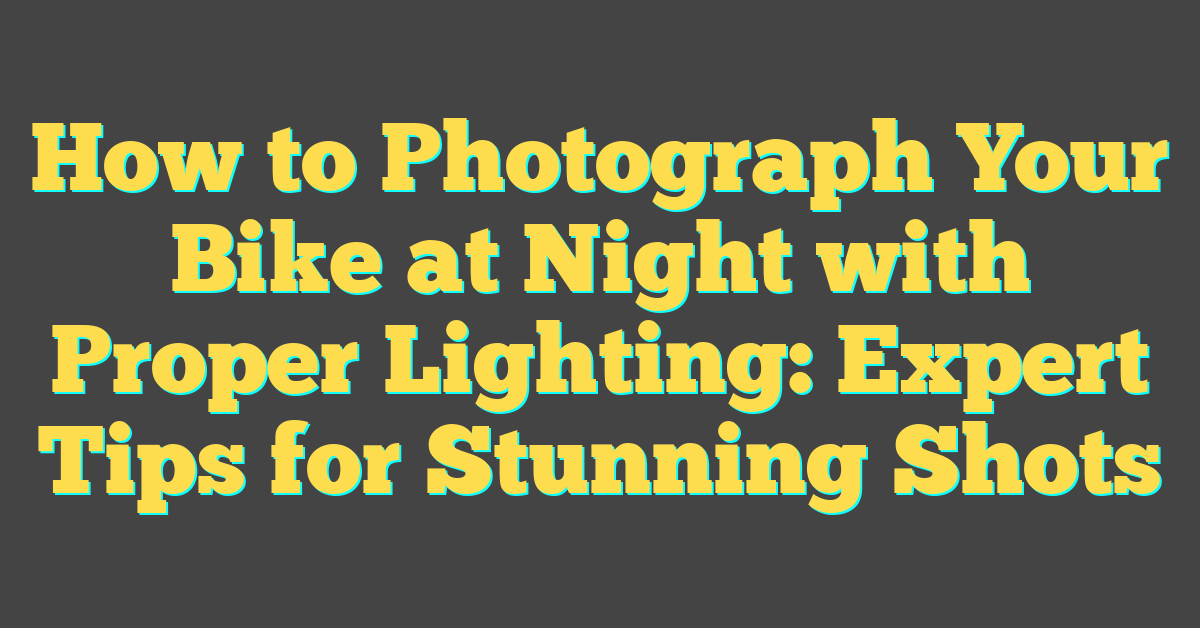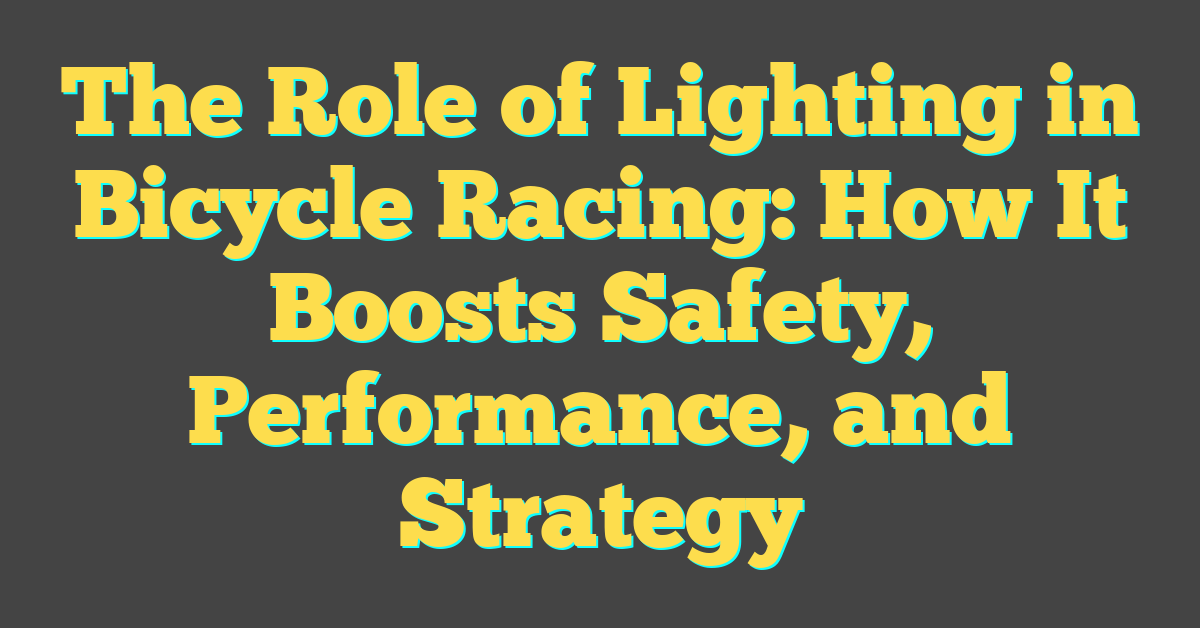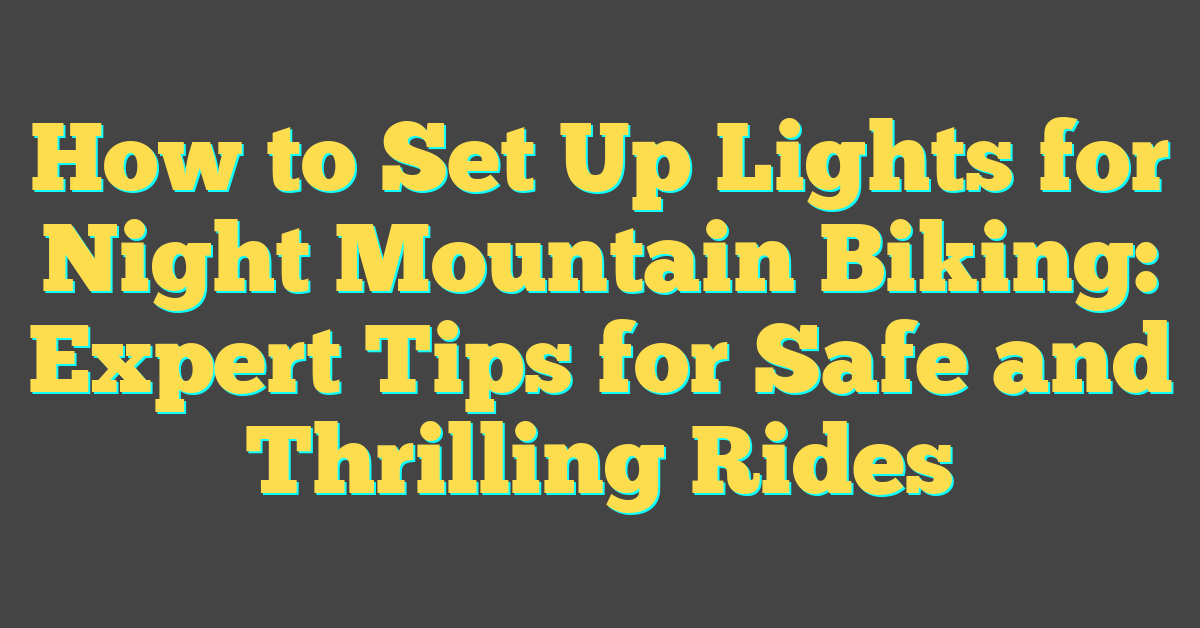There’s something magical about capturing your bike under the glow of the night. The way the lights play off its frame and the shadows create depth can turn an ordinary shot into a work of art. But let’s be honest—getting that perfect nighttime photo isn’t as simple as pointing and shooting. Without the right lighting, your bike might end up looking more like a shadowy blur than a masterpiece.

I’ve spent countless nights experimenting with angles, light sources, and camera settings to figure out the best way to showcase a bike after dark. Whether you’re using a smartphone or a DSLR, the right approach can make all the difference. If you’ve been wondering how to make your bike photos truly pop at night, don’t worry—I’ve got you covered. Let’s dive into the basics of lighting and techniques to help you nail that perfect shot.
Why Night Bike Photography Is Unique
Night bike photography stands out due to the interplay of artificial light and shadows, creating a dramatic ambiance that’s impossible to replicate during the day. The lack of natural light makes it necessary to rely on creative lighting solutions, where everything from bike headlights to portable LED strips can enhance the scene. This challenge is what makes it an exciting pursuit.
Bikes possess intricate details, like spokes, chains, or handlebars, that reflect light in unique ways under controlled settings. Capturing these reflective elements at night allows me to highlight textures and components that might otherwise go unnoticed. It’s all about using light precision to tell a visual story that feels dynamic.
Urban backdrops can amplify the uniqueness of night shots. Streetlights, neon signs, and passing vehicles create opportunities for creative light trails and contrasting tones. Incorporating such elements lets me transform ordinary bike shots into compelling compositions.
Every night shoot is different because environmental light sources constantly change. This forces me to think on my feet, adjust lighting angles, and experiment with exposure settings to achieve the desired effect. That unpredictable nature keeps the process fresh and rewarding.
Essential Equipment for Night Bike Photography
Capturing your bike at night requires specialized gear to handle low-light conditions. With the right equipment, you can highlight your bike’s features while creating striking visuals.
Choosing the Right Camera
A camera capable of performing well in low-light is crucial. I prefer using a DSLR or mirrorless camera with adjustable settings for ISO, aperture, and shutter speed. Models like the Canon EOS R6 or Sony A7 III work exceptionally well in dim conditions. For smartphone photography, options like the iPhone 14 Pro or Google Pixel 7 Pro, which excel in night mode, produce great results too.
Lighting Tools and Accessories
Lighting determines the mood and clarity of a nighttime bike photo. My go-to is a set of portable LED light panels (e.g., Lume Cube or Neewer LED lights) for consistent brightness. Bike-specific lights, like handlebar-mounted headlights, add a natural source and help emphasize bike-specific details. For creative effects, I also love strapping LED light strips or using RGB light wands to generate colored highlights. Headlamps and flashlights work nicely for focused lighting on sprockets, chains, or handlebars.
Tripod and Stability Options
Stability is a game changer for long exposure shots. A sturdy tripod is non-negotiable for me; I usually go for a carbon fiber tripod like the Manfrotto Befree Advanced for its portability and durability. If you’re on a budget, there are compact options like the Joby GorillaPod that are versatile and easy to pack for rides. For smartphone users, I always recommend a clamp tripod mount combined with a small tripod to keep the phone steady during extended exposure.
Setting up the Perfect Shot
Capturing your bike at night starts with thoughtful preparation. With the right location, camera settings, and bike positioning, you can highlight every detail under dramatic lighting.
Finding the Ideal Location
Choosing a location plays a big role in the mood of your shot. I look for areas with interesting background lights, like neon signs, streetlights, or cityscapes. Quiet streets or parking lots work well if you want a clean and minimalist environment. Avoid spots with excessive ambient light to maintain control over your setup.
For creative outdoor shots, I recommend locations like underlit bridges, trails with subtle path lighting, or urban walls illuminated by nearby light sources. These can add depth and context to your photos while keeping the focus on your bike.
Adjusting Camera Settings for Low Light
Using the right camera settings is essential for capturing clear, well-lit shots in the dark. I start by setting my ISO to around 800-1600 on my DSLR or mirrorless camera, balancing light sensitivity without adding too much noise. For smartphones, I enable night mode and use manual controls if available.
I suggest keeping the shutter speed slow, like 1/10 to 1/30 seconds, to allow more light in, especially if you’re using additional lighting. Always pair this with a tripod to avoid motion blur from hand movements. Use aperture settings between f/2.8 and f/4 for sharp focus while letting in enough light. Experiment with white balance based on your lighting setup, whether it’s cool LEDs or warm bike headlights.
Positioning Your Bike for Best Results
« The Psychology of Color in Bicycle Lighting: How Color Choices Can Save Lives on the Road
Bicycle Lighting in Art and Design: How Creativity and Innovation Illuminate Urban Culture »
Positioning your bike properly ensures its features are showcased. I aim for a three-quarter angle, combining a side and slight front view to make the frame, wheels, and handlebars stand out. Adjust the bike’s orientation to work with diagonal or leading lines in the background for dynamic composition.
Keeping the bike stable is key for longer exposures. If your kickstand isn’t reliable, prop your bike with a hidden support like a rock or stand positioned out of frame. Highlight details like the spokes, chain, or rims by angling portable lights or your bike’s headlight towards them. This adds sharpness and texture that stand out in night photography.
Mastering Lighting Techniques
Proper lighting transforms a nighttime bike photo from a simple image to a stunning piece of art. Experimenting with light placement, intensity, and angle creates depth and draws attention to your bike’s unique features.
Using Artificial Lighting
Adding artificial lighting gives full control over shadows and highlights. I use portable LED light panels, bike-mounted headlights, and strip lights to create dynamic effects. For example, placing an LED panel low and angled upward emphasizes the bike’s frame, while strip lights attached to the wheels illuminate rotating spokes. Adjust light intensity to prevent over-brightening certain areas, ensuring balance across the frame.
RGB lights work great for a creative flair. I sometimes opt for a soft blue hue along the frame to replicate the cool tones of nighttime, contrasting it with warm amber under my tires for a glowing ground effect. Use clamp mounts to position lights securely during extended shoots.
Working with Available Ambient Light
Ambient light adds character to photos through streetlights, neon signs, or passing car headlights. I scout locations that have unique ambient sources, like underpasses with colorful LED installations or city streets glowing with store signs. These lights often create natural highlights and reflections on the bike’s frame.
I occasionally incorporate light trails from car brakes or city traffic by using a slower shutter speed. For still shots surrounded by faint ambient lighting, using a wider aperture helps capture the energy of the surroundings while keeping the bike in focus.
Avoiding Overexposure and Shadows
Balancing exposure ensures details stand out without sacrificing clarity. Overexposing headlights or reflective surfaces on the bike disrupts the overall photo. I lower my artificial light’s brightness, especially when paired with a strong ambient source. Using diffusers softens harsh lights, reducing glare and preserving a natural look.
Shadow control is equally crucial. To avoid harsh shadows under the bike, I position lights at varying angles, like directly above or at a side tilt. A secondary, dimmer light eliminates heavy shadow depth and balances the composition, enhancing the nighttime vibe without overpowering the subject.
Post-Processing Tips for Night Bike Images
Editing enhances the work you’ve already put into lighting and composition during the shoot. It’s my favorite step to bring the scene to life and highlight the unique character of your bike. I use these tips to refine nighttime bike photos.
Adjust Exposure and Contrast
Start by correcting the exposure if the image appears too dark. Dark areas in night photos sometimes lose detail, so raising the shadows carefully can restore depth without making the image look flat. Increasing contrast helps emphasize the bike’s shapes and textures, like the lines of the frame or the shine on the spokes.
Fine-Tune White Balance
White balance can shift under artificial or mixed lighting. Using warm tones creates a cozy, atmospheric effect, while cooler tones feel sleek and modern. I manually adjust the color temperature in software like Lightroom to match the mood I want. For neon backgrounds or RGB lighting effects, experiment until the colors pop without looking unnatural.
Highlight Bike Details
Showcasing the bike’s features adds visual interest. I selectively sharpen intricate parts, such as the chain, gears, or tire treads. Using clarity sliders enhances these areas without over-processing the whole image. Tools like radial filters can further draw attention to specific details by brightening or saturating them subtly.
Reduce Noise in Low-Light Shots
Noise becomes noticeable when shooting at high ISO, common in night photography. Noise reduction tools soften grainy parts while preserving sharpness in the bike. I focus on areas like the sky or shadows where noise typically stands out most.
Enhance Ambient Lighting
Ambient light provides depth and mood, so accentuating it adds drama. Boosting the luminance from streetlights, neon signs, or headlamp beams makes them glow naturally. If light trails are part of the composition, increasing their saturation or vibrancy enhances their energy.
Use Creative Cropping
Cropping simplifies the frame and strengthens composition. I remove distractions in the background or trim unnecessary space to focus on the bike. Keeping a sense of balance ensures the bike remains the primary subject.
Apply Subtle Vignettes
Adding a slight vignette emphasizes the bike by subtly darkening the edges of the image. It’s especially useful for directing attention to the center of the frame during night photography when backgrounds can overwhelm the subject.
Save and Export for Display
Export settings should preserve the quality of your edits. For sharing online, I prefer high-resolution JPEGs or PNGs with optimized dimensions that suit platforms like Instagram. For printing, saving as a high-quality TIFF ensures the final output looks its best.
Combining precise adjustments with creative tweaks enhances every photo. It’s incredibly rewarding to see the bike and lighting I worked so hard to set up during the shoot look even better in the final image.
Common Mistakes to Avoid
Overexposing the subject leads to washed-out details and reduces overall image quality. Keeping the lighting balanced ensures the bike’s texture and features stand out. For example, avoid directing strong lights like portable LEDs fully onto reflective surfaces, such as metallic frames or chrome.
Relying solely on ambient light often results in underexposed or grainy photos. While neon signs and streetlights add ambiance, they rarely provide sufficient illumination for clear shots. Incorporating portable lighting tools ensures key details, like spokes and chains, are visible.
Ignoring shadows creates a flat composition that lacks depth. Proper positioning of light sources introduces contrast, emphasizing the bike’s unique design. For instance, placing a secondary light at an angle can enhance the three-dimensional appearance of rims and chains.
Neglecting tripod usage causes blur, especially in long exposures. Stability is critical in low light. A reliable tripod ensures sharp images, even with slower shutter speeds or handheld setups. This applies equally to DSLRs and smartphones when capturing intricate bike details.
Using incorrect white balance skews colors, making the bike look unnatural. Setting white balance according to lighting conditions, like warm streetlights or cool LEDs, maintains accurate tones.
Over-editing in post-processing diminishes authenticity. Subtle adjustments enhance the bike’s features without distorting reality. For instance, a slight contrast boost highlights details without overwhelming the image.
Conclusion
Photographing your bike at night is such a rewarding experience when you combine creativity with the right techniques. It’s all about experimenting with lighting, settings, and angles to create images that truly stand out. With a little preparation and patience, you can capture stunning shots that highlight your bike’s unique details and personality.
Don’t be afraid to try new approaches and embrace the challenges that come with nighttime photography. Every shoot is an opportunity to learn and grow as a photographer. So grab your gear, find the perfect spot, and let your creativity shine through the night!




